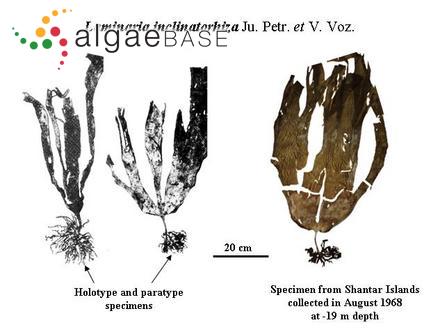Laminaria inclinatorhiza J.E.Petrov & V.B.Vozzhinskaya 1970

Current name:
Laminaria inclinatorhiza J.E.Petrov & V.B.Vozzhinskaya
Kvachina Bay (north-western Kamchatka, the Sea of Okhotsk), Russian Federation and Shantar Islands (right-hand specimen). Composite image by Dr. Olga Selivanova (oselivanova@mail.ru),
showing type specimen of the species (black and white image, left) an - 24 August 1963. Olga Selivanova (oselivanova@mail.ru)
Publication Details
Laminaria inclinatorhiza J.E.Petrov & V.B.Vozzhinskaya 1970: 84
Published in: Petrov, J.E. & Vozzhinskaja, V.B. (1970). [New species of the genus Laminaria from the Sea of Okhotsk]. Novosti Sistematiki Nizshikh Rastenii (Novitates Systematicae Plantarum non Vascularium) 7: 81-87. [in Russian]
Type Species
The type species (lectotype) of the genus Laminaria is Laminaria digitata (Hudson) J.V.Lamouroux.
Status of Name
This name is of an entity that is currently accepted taxonomically.
Type Information
Type locality: USSR, the Sea of Okhotsk, Kvachina Bay (north-western Kamchatka); Holotype: V.B. Vozzhinskaya; August 24, 1963; Komarov Botanical Institute, Academy of Sciences of the USSR (Leningrad).;
Description
The thalli are of intermediate size, up to 80 cm in total height. They consist of an entire or dissected blade, a terete stipe, and an unusual cone-shaped rhizoidal holdfast. The blades reach 74 cm in length and are rounded to elongate-elliptical in shape. They are flat or concave at the base and often deeply dissected. The medulla occupies about 22% of the blade thickness. The blade cortex bears numerous mucilage ducts that are large (80 x 120 µm) and close to one another (20-180 µm apart). They distance from the blade surface to the center of a mucilaginous duct to the medulla is in a ratio of 1:2.1 to 1:2.5. Mucilaginous ducts and lacunae are absent from both the stipe and holdfast. The stipe is erect, 10 mm in diameter and 30-70 mm long. The holdfast contains whorls of haptera that are initiated obliquely from the stipe. As they grow, they extend downward for about 4 cm and are often unbranched except at their tips where they weakly divide to provide attachment. This creates a cone-shaped profile to the holdfast that can be nearly as tall as the stipe is long. The maximum width (5.5-6 mm) and thickness (up to 4.2 mm) occurs in the middle of the haptera and they are narrowest near the stipe (to 2.7 mm). The haptera are fragile and easily break off, especially in herbarium samples. Sporangia are found on the blades from late July-September. They develop on both surfaces of the blade and the soral areas conicide in location. (Translated from Russian by O.N. Selivanova)
Distribution: The Sea of Okhotsk: northern coast (Babushkin Cape) and north-western coast of Kamchatka (from Khairyuzov Cape to Tigil estuary); Shantar Islands.
Habitat
On rocks at depths of -2 to -19 m, often in silty habitats.
Key Characteristics
Similar Species
This species differs from L. digitata and other similar species by the morphology of the holdfast and by the location of the sporangial sori. L. digitata is absent from the Sea of Okhotsk, and it is likely that authors recording this species were actually referring to either L. appressizhiza or L. inclinatorhiza.
Created: 28 October 2006 by M.D. Guiry.
Last updated: 20 September 2012
Verification of Data
Users are responsible for verifying the accuracy of information before use, as noted on the website Content page.
Linking to this page: https://www.algaebase.org/search/species/detail/?species_id=131557
Citing AlgaeBase
Cite this record as:
M.D. Guiry in Guiry, M.D. & Guiry, G.M. 20 September 2012. AlgaeBase. World-wide electronic publication, National University of Ireland, Galway. https://www.algaebase.org; searched on 23 November 2024















